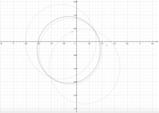Svolgimento:
a) va azzerato il coefficiente della[math]x[/math]
, quindi [math]k=1/2[/math]
e la retta ha equazione [math]y=1/9[/math]
b) il coeff. angolare di [math]4x+y+7=0[/math]
è [math]-4[/math]
, quindi la retta perpendicolare avrà coeff. angolare pari a [math]1/4[/math]
. Allora
[math](1-2k)/(k-5)=1/4[/math]
da cui [math]k=1[/math]
; l'equazione della retta è [math]x-4y+1=0[/math]
c) il coeff. angolare di [math]2x+y+7=0[/math]
è [math]-2[/math]
, allora
[math](1-2k)/(k-5)=-2[/math]
perciò nessun valore di [math]k[/math]
d) il coeff. angolare dev'essere uguale a [math]-1[/math]
:
[math](1-2k)/(k-5)=-1[/math]
da cui [math]k=-4[/math]
e l'equazione della retta è [math]9x+9y+4=0[/math]
Il centro del fascio si può calcolare ponendo a sistema
per esempio[math]x=-5/9[/math]
(retta ottenuta per [math]k=5, perché in tal modo si azzera il coefficiente della [/math]
y[math] e si semplificano i calcoli per il sistema) ed [/math]
y=(-1/5)x[math] (retta otte
uta per [/math]
k=0uta per [/math]
[math]). Quin di [/math]
{(x=-5/9),(y=(-1/5)x):}$ {y=(-1/5)x
Sostituisco nella seconda e ottengo: [math]y=1/9[/math]
Quindi il centro ha coordinate $C(-5/9;1/9)$







 Accedi a tutti gli appunti
Accedi a tutti gli appunti
 Tutor AI: studia meglio e in meno tempo
Tutor AI: studia meglio e in meno tempo